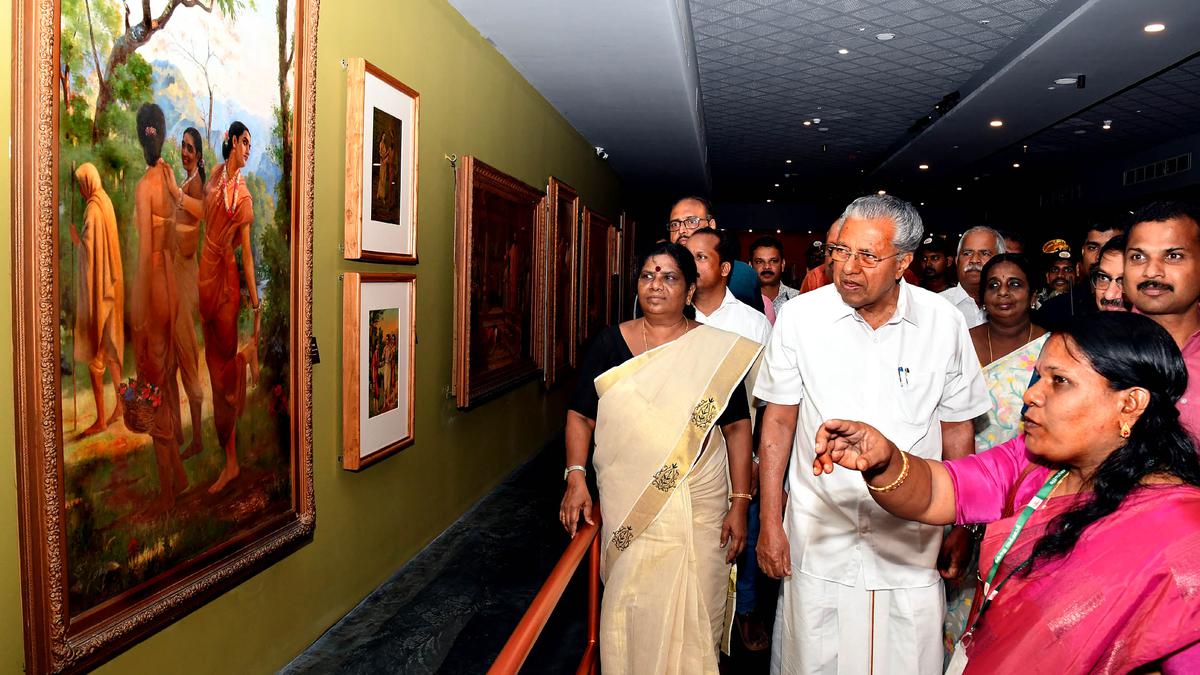
Raja Ravi Varma Art Gallery inaugurated in Thiruvananthapuram
The Hindu
The new gallery has the largest collection of Ravi Varma paintings in India and is being opened at a time when the 175th birth anniversary of the artist is being celebrated
Chief Minister Pinarayi Vijayan inaugurated the Raja Ravi Varma Art Gallery on the Napier Museum premises on Monday, calling it a tribute to the genius of one of the foremost artists in the history of the nation.
Mr. Vijayan said the new gallery had the largest collection of Ravi Varma paintings in India. It was also a matter of great joy that the art gallery was being opened at a time when the 175th birth anniversary of the artist was being celebrated in different parts of the world, he added.
Indian traditions and western techniques harmoniously blend in Ravi Varma’s works, which marked a renaissance in Indian art, the Chief Minister said. While Ravi Varma was celebrated across the globe, Kerala was yet to recognise his true worth, the Chief Minister said, stressing the need to protect and cherish his works.
His works were declared national treasures so that they were not taken abroad. The art gallery contained works transferred by the Kilimanoor Palace. The State had a duty to protect them for posterity, he said.
Developed by the State Museums department at a cost of ₹7.90 crore, the art gallery has 135 works by Ravi Varma, his brother Rajaraja Varma, his sister Mangala Bayi, and other artists who were their contemporaries.
By opening the gallery, the State had made a dream dating back to 1977 come true, Minister for Archaeology and Archives Ahamed Devarakovil, who presided, said. Minister for Animal Husbandry J. Chinchurani, V.K. Prasanth, MLA, Mayor Arya Rajendran, Chief Secretary V. Venu, and other officials were present at the event.

“Writing, in general, is a very solitary process,” says Yauvanika Chopra, Associate Director at The New India Foundation (NIF), which, earlier this year, announced the 12th edition of its NIF Book Fellowships for research and scholarship about Indian history after Independence. While authors, in general, are built for it, it can still get very lonely, says Chopra, pointing out that the fellowship’s community support is as valuable as the monetary benefits it offers. “There is a solid community of NIF fellows, trustees, language experts, jury members, all of whom are incredibly competent,” she says. “They really help make authors feel supported from manuscript to publication, so you never feel like you’re struggling through isolation.”

Several principals of government and private schools in Delhi on Tuesday said the Directorate of Education (DoE) circular from a day earlier, directing schools to conduct classes in ‘hybrid’ mode, had caused confusion regarding day-to-day operations as they did not know how many students would return to school from Wednesday and how would teachers instruct in two modes — online and in person — at once. The DoE circular on Monday had also stated that the option to “exercise online mode of education, wherever available, shall vest with the students and their guardians”. Several schoolteachers also expressed confusion regarding the DoE order. A government schoolteacher said he was unsure of how to cope with the resumption of physical classes, given that the order directing government offices to ensure that 50% of the employees work from home is still in place. On Monday, the Commission for Air Quality Management in the National Capital Region and Adjoining Areas (CAQM) had, on the orders of the Supreme Court, directed schools in Delhi-NCR to shift classes to the hybrid mode, following which the DoE had issued the circular. The court had urged the Centre’s pollution watchdog to consider restarting physical classes due to many students missing out on the mid-day meals and lacking the necessary means to attend classes online. The CAQM had, on November 20, asked schools in Delhi-NCR to shift to the online mode of teaching.









